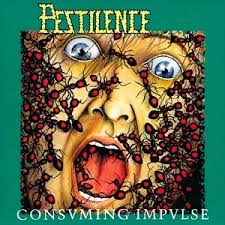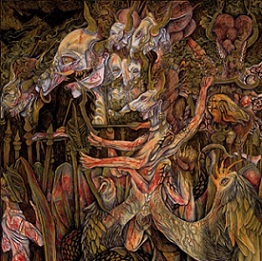The good ship Pestilence has once again been making the rounds on the local ragebait circuit. Older acts that seemingly exist solely to spite their legacy (usually at the behest of one remaining member living on reputational fumes) are hardly unique in metal, but Pestilence attract a uniquely visceral ire from long time fans.
What a time to once again dive back to the reasons people even care about this band in the first place. Having long neglected their first two albums for the sake of a deeper scrutiny of their early progressive era, I have since been correcting this error with some intensive sessions with ‘Consvming Impvlse’. The first thing to note is its place in the chronology of death metal. Pestilence arrived early enough that we can document the develop of death metal from the residual thrash influence from their early demos into ‘Mallevs Maleficarvm’, with 1989 marking – for all intents and purposes – the beginning of full blooded death metal, with Obituary, Morbid Angel, and Autopsy all throwing their hat in the ring with full length offerings.

Pestilence’s contribution in the form of ‘Consvming Impvlse’ is perhaps only contemporaneously matched by ‘Altars of Madness’ for its untroubled swagger. This is fully formed death metal in every sense of the word. The riffs take on angular provocations, weaving labyrinthine chromatic threads that upset the apple cart of linear thrash. The drums are perhaps the most notable vestige of the genre’s lineage, unfurling a pounding consistency of traditional rhythmic currents and evolved d-beats. But this only serves to further highlight just how disorientating and meandering the riffs were becoming, even as they were delivered in predictably quantifiable sequences.
The production itself lends the album a mechanical nihilism, as the DIY inheritance of thrash and punk gives way to the art of capturing a theatrical experience that goes beyond the immediacy of the musicians’ individual circumstances. Tracks like ‘Suspended Animation’ and ‘Echoes of Death’ echoing [sic] ‘Altars of Madness’ for their subtle use of synths. In this context it would be remiss not to mention van Drunen’s vocals, which, alongside John Tardy, bring to life that sense of occasion and higher purpose that– over and above compositional rudiments – would set death metal apart from what had come before.
I can only assume that I was not the only one to be subject to this freak of the YouTube algorithm when it recommended this obscure anomaly of late 90s death metal. The Slovakian oddball known as Mentality released only one album, ‘Teonanacatl’ in 1998, fitting into that brief but vibrant pocket of activity within the genre after its initial early 90s peak but just prior to its ultimate decline by the new century.

The album pleases more in an academic sense than the raw enjoyment to be mined from coherent works. Perhaps too anomic for its own good, ‘Teonanacatl’ is stuffed with the detritus of early 90s extreme metal to the point of losing all coherence. But as a first draft of a kind of symphonic, technical grindcore (honestly the only serviceable term that comes to mind) it should be applauded for its sheer audacity if nothing else. Spiritually if not in pure musical terms we could see this as an inheritance of other fluke releases such as diSEMBOWELMENT’s ‘Transcendence into the Peripheral’ married to early Carbonized material.
That being said, the music tears itself apart in a way anticipating techdeath, something borne out by the bipolar vocal delivery of guttural and high end screeching. One Brano Kopas is credited as full time keyboardist, delivering a cornucopia of synth punches and orchestra hits that will sound almost kitsch to modern ears. That being said, one can’t help but appreciate the adoption of patches and techniques seemingly borrowed from mid-90s rave, something rarely seen in metal outside of explicitly industrial stylings. The fact that they take a genuine lead role and at times inform the direction of composition is in stark contrast to the likes of Louis Panzer who, despite blazing a trail in Nocturnus, was never quite up to delivering on the promise of progressively inclined keyboard driven metal.
There is an organic carelessness in Mentality’s willingness to reach for the bizarre. A natural avant-gardism that stands apart from modern contrivances. A clear respect for (and ability to give voice to) the arcane language of death metal riffing is offset by a willingness to explode conventional wisdom apart just to study the remains.
Howls of Ebb are emblematic of that high minded impulse in metal that ran converse to the retro trends of the 2010s. Namely a push to forced avant-gardism via an overreliance on dissonance and stretches of dark ambient or noise extended well passed their shelf live as a way to short circuit tension into the mix. I label Howls of Ebb as emblematic because their work is not entirely terrible, although the ‘The Marrow Veil’ EP is perhaps their most successful attempt at this when taken against the two albums it bisects.

The reason for this is a willingness to lean into the non-riff based avant-garde tendencies further. When they attempt to concoct these tentacle like passages of complex, jagged riffing it brings the formula too close to Krallice or Behold the Arctopus redundancies, and one can’t but wish they’d stop trying to speak in a language that should be familiar were it not for the fact that the words, grammar and sentences are jumbled beyond reason.
On ‘The Marrow Veil’ this tendency is diminished to an extent, allowing a more modest riff package to come to the fore, one basic in its intent but no less effective for the fact. Atop this Howls of Ebb are able to lean into their industrial and dark ambient tendencies in a manner similar to The Ruins of Beverast but untroubled by the absurdly laboured approach to composition.
The EP still lacks coherence, dwelling too long on individual ideas or breaks into dark ambience long enough to make one forget that they’re listening to a metal album yet go nowhere as far as extending the atmospheric intent is concerned. This latter comes from an inability to properly integrate doom metal into the formula, mistaking the genre’s spacious ethos for a simple, monotonous drone.
But between the cracks emerges one of the more convincing iterations of self-conscious avant-gardism in the mid-2010s. One with a clear riff coherence and a willingness and ability to connect this up with an interesting atmospheric intent, elevated not least by simple yet effective lead guitar material, notably for its juxtaposition of an almost playful lyricism, working in neat contrast to the explicitly despondent atmosphere permeating the rest of the music.
Leave a comment